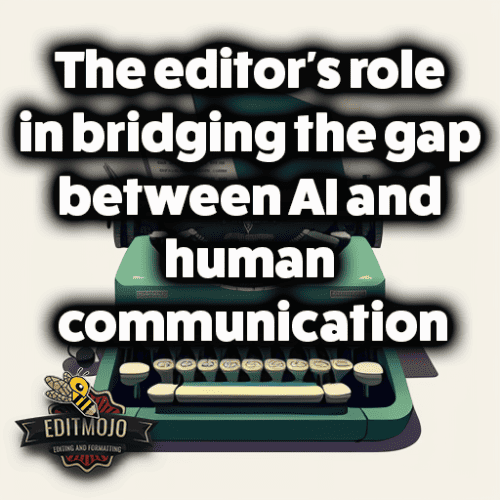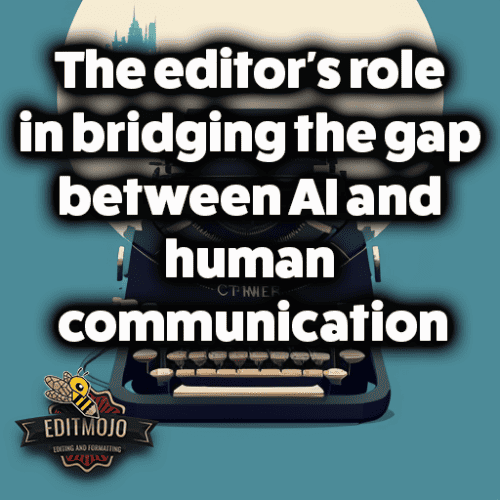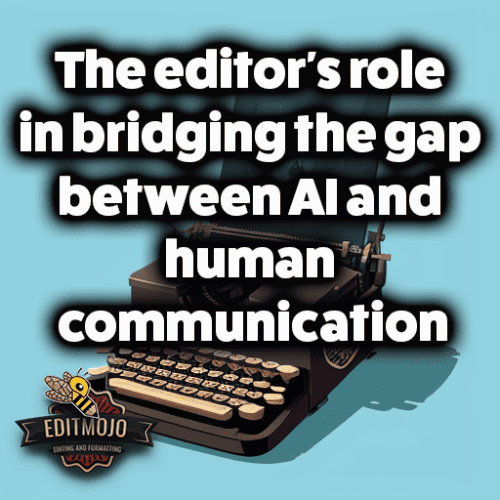The editor’s role in bridging the gap between AI and human communication
The editor’s role in bridging the gap between AI and human communication. Artificial Intelligence (AI) has come a long way since its inception, gradually infiltrating all facets of our lives, from self-driving cars to voice assistants. Particularly, AI’s role in communication is both exhilarating and challenging. The emergence of chatbots and virtual assistants, such as Alexa and Siri, has underscored AI’s potential, but also highlighted the disparities between AI and human communication. Amid this backdrop, an unexpected protagonist surfaces: the editor. The traditional curator and enhancer of human communication, now finds themselves tasked with humanizing AI.
Key Takeaways Table
| Topic | Key Points |
|---|---|
| AI and Human Communication | AI communication is based on algorithms, lacks emotional intelligence, and often misunderstands nuances of human language. |
| The Editor’s Traditional Role | Editors refine and enhance human communication, ensuring clarity, relevance, and resonance with the audience. |
| The Editor’s Role in AI Communication | Editors curate AI-generated content, train AI models on understanding human language, and serve as ethical overseers. |
| Case Studies | OpenAI’s ChatGPT and Grammarly successfully leverage editors’ skills in improving AI communication. |
| Future Perspectives | The editing profession is evolving with the integration of AI, posing both challenges and opportunities. |
Understanding AI and Human Communication
Artificial Intelligence communicates differently. Its language is built on complex algorithms and machine learning models, trained to respond to prompts and recognize patterns. However, its capabilities, while impressive, are somewhat bounded by its inability to fully grasp the intricacies of human language.
In stark contrast, human communication thrives on emotion, subtle nuances, and contextual understanding. We express ourselves using idioms, sarcasm, humor, and other linguistic quirks. These complex elements often elude AI, creating a gap that poses significant challenges, particularly in instances where precise understanding and empathy are essential.
Consider AI in customer service, where misunderstanding a frustrated customer’s context could lead to dissatisfaction, or in healthcare, where AI misunderstanding a patient’s symptoms could lead to erroneous advice. These are potential scenarios that emphasize the importance of bridging this communication gap.

The Role of the Editor in Traditional Contexts
Traditionally, editors are the gatekeepers of communication. They refine and polish written content, ensuring clarity, coherence, and relevance. A great editor, armed with a strong grasp of language and a keen eye for detail, can transform a good piece into a masterpiece. They also carry the responsibility of understanding the audience, shaping the content to be engaging and understandable. The ability of an editor to intuitively sense what will resonate with an audience is a uniquely human attribute that AI has yet to emulate.
The Editor’s Role in AI Communication
In the realm of AI communication, the editor’s role is magnified and multifaceted. Editors curate AI-generated content, tailoring the language to be more ‘human’. They check for relevance, ensuring AI output aligns with the context, and add the much-needed human touch, enhancing the tone and style to resonate better with human users.
Editors also play a critical role in training AI models, helping them better understand and mimic human language. By providing feedback and editing AI-generated content, editors contribute to improving the machine’s understanding of nuances, idioms, and other complex elements of language.
Arguably, one of the most important roles an editor plays in AI communication is that of an ethical overseer. Ensuring that AI models don’t perpetuate biases, and that the communication they facilitate is fair and transparent, is paramount. This role requires a level of moral and ethical judgement that AI lacks, but which editors, drawing on their humanity, can provide.
Case Studies: The Editor’s Influence on AI Communication
An example of the successful integration of editors in AI communication is ChatGPT, developed by OpenAI. Here, editors were instrumental in the training process, providing user simulations and reviewing AI outputs. Their input was critical in shaping the model’s understanding of language and context.
Similarly, at Grammarly, a digital writing tool that leverages AI, editors play a crucial role. They work in tandem with the AI, learning from each other. The editors help fine-tune the AI, while the AI aids in identifying writing issues. This synergy has led to a tool that provides more accurate and helpful suggestions to users.
Despite these strides, the journey is far from over. Editors continue to navigate challenges such as training AI on abstract concepts like sarcasm and humor, and dealing with unforeseen biases that emerge in AI outputs. The learning curve is steep, but the successes achieved so far are encouraging.

Future Perspectives: The evolving role of the editor
As AI becomes more ingrained in communication, the need for editors in this space grows. The responsibilities are no longer just about refining human language but extending these skills to humanize machine language. For the editing profession, this means an expanded scope and a reimagining of their roles.
Yet, alongside the increasing importance of this role, lie potential future challenges. The nuances of language are infinite and ever-evolving. Training AI to grasp these intricacies, while ensuring ethical use, presents a continually moving target. The road ahead may be riddled with obstacles, but the opportunity for innovation is ripe, and the potential benefits enormous.
Conclusion (The editor’s role in bridging the gap between AI and human communication)
The editor’s role in bridging the gap between AI and human communication is pivotal. The responsibility of humanizing AI communication, training AI models, and ensuring ethical AI use, underscores the importance of this role. As AI continues to make strides in communication, the need for a human touch persists. Thus, the collaboration between AI and editors remains essential, underscoring the perpetual need for the human in the digital world.
As we navigate this intersection of AI and language, the words of writer Isaac Asimov resonate, “The machine does not isolate us from the great problems of nature but plunges us more deeply into them.” In this context, the ‘machine’ is AI, the ‘nature’ is human language, and the ‘us’ includes, prominently, the editor.
Top Five Questions and Answers Table
| Question | Answer |
|---|---|
| How does AI communication differ from human communication? | AI communication is based on algorithms and pattern recognition, lacking the ability to grasp subtle nuances, emotional cues, and implicit meanings common in human communication. |
| What is the traditional role of an editor? | An editor refines and enhances human communication by ensuring clarity, coherence, and relevance. They also tailor the content to resonate with the audience. |
| How can an editor improve AI communication? | Editors can improve AI communication by curating and refining AI-generated content, training AI models on understanding human language, and ensuring ethical use of AI. |
| Are there successful examples of editors improving AI communication? | Yes, examples include OpenAI’s ChatGPT and Grammarly, where editors played a key role in training and refining the AI models for improved communication. |
| How is the editing profession evolving with AI integration? | The editing profession is expanding its scope to include training and refining AI models, enhancing AI-generated content, and overseeing the ethical use of AI. |

Top Ten Resources and Further Reading Table
| Resource | Topic |
|---|---|
| OpenAI | Research and developments in AI |
| Grammarly Blog | Insights into the integration of AI in language editing |
| Stanford’s Human-Centered AI | Research on human-centered AI |
| MIT Technology Review | Articles on the latest in AI technology |
| Harvard Business Review: AI | Business perspectives on AI |
| AI & Society Journal | Academic research on the social implications of AI |
| The AI Now Institute | Research on the social implications of AI |
| Google AI Blog | Insights into Google’s AI research |
| The Guardian: AI | News and articles on AI |
| Artificial Intelligence Journal | Academic research on AI |
